GMS Junior Section Field Trip September 2024
If you have any questions about field trips send email toGMS Junior Section Field Trip
Tours, Gold, Picnic, and FRA Badge in Georgia
Saturday, September 14, 2024
With tropical storm remnants to our west, and a developing system to our east, we had to thread through a narrow weather needle. A few days before the trip, Charles consulted with Micky McClain, our official GMS meteorologist, who explained that we would get a little bit of rain, but not enough to cause any grief. His forecast was exactly right! Except for a bit of misty rain here and there, we did not have to dodge any raindrops. But, because of the possibility of rain, the optional train ride that was scheduled to be the last thing in the day was rescheduled to be the first thing in the day. So, we started our adventures with a tiny train trip around the park. We saw several mining structures along the way, and everyone enjoyed the exhilarating ride.
This location has so much to offer that with just one field trip, we realized juniors could earn an American Federation of Mineralogical Societies (AFMS) Future Rockhounds of America (FRA) badge! For the Gold and Prospecting Badge, we planned the following activities: 1) field trip to a gold mine, 2) wildcard – in this case, learning about minerals associated with gold, and 3) gold panning. Note: FRA badges are provided free of charge when a junior completes required activities and submits a signed badge form.
We continued the day with a guided tour of the museum led by Amy, museum assistant and archival specialist. Juniors learned about the history of gold mining in Georgia, and they got to see several gold mining artifacts found on the property. Maps and other documents prove that the Georgia gold rush actually began unofficially in the Villa Rica area a few years before it continued officially in Dahlonega. Various sizes and types of gold pans were on display, and juniors were challenged to contemplate how daunting it must have been to pan for gold with a super heavy cast iron pan, as many miners did before they had proper gold pans. Several pieces of mining equipment that were actually used at the gold mine were on display, and Amy explained how they were used. Juniors enjoyed the mineral exhibits too, including one filled with fictional “minerals” from movies, books, and comics.
After the museum tour, we took a break for a picnic lunch in a large pavilion at the museum. Cameron Clines grilled up a heap o’ hot diggity dogs, and members brought juice, fruit, cookies, chips, and even some delectable homemade spinach and cheese spanakopita! After lunch, Cam showed us an array of gold panning tools. Juniors learned why gold pans have ridges (to help accumulate and keep gold in the pan as the pan is moved around in water); how to remove magnetite and other particles using a magnet; and how to remove the gold from the pan using a pipette. Wesley, the museum director, brought out a cast iron pan so juniors could compare it to the modern plastic pans.
Well-versed on the history of the site and how gold mining there was performed, we began a tour through the old mine. Juniors learned about the Stockmar family that owned the mine and lived on the property. The patriarch of the family, Buddy Stockmar, invented a type of concrete black called a “T-Block” that was made using sand from the mine tailings. Juniors got to see some actual T-Blocks in a building that was once used as Buddy’s office. They also strolled around within the ruins of the Stockmar house, and examined close-up how the house was built out of the quartz rocks from the mine. Walking through the woods, we stopped to peer over a fence. We saw a large pit that is currently all there is to see of the massive gold ore quarry. Many tons of rocks were removed from that hole, which is a fraction of the size it once was. The loosely consolidated quartz was crushed, which allowed very fine gold dust to be extracted via chemical processing that involved the use of cyanide and mercury. Juniors returned to the picnic pavilion with the first activity for earning their badge complete: 1) field trip to a gold mine!
Next up: 2) wildcard – learning about minerals associated with gold. Using pre-punched 3” x 5” index cards, sturdy commercial shipping tape, and some sand donated by GMS member Bob Brady, juniors made sand cards that functioned as slides for viewing with a microscope. Bob collected the sand when he panned for gold in a creek in Georgia. Juniors used a digital microscope to magnify the sand grains so they could see the various minerals associated with gold in Georgia. They could see right away the beautiful red and pink garnet sand as well as the dark staurolite and magnetite grains. There were still a few bits of quartz left from the panning too. One lucky junior even got a tiny piece of gold on his card!
Excited after seeing the sand, juniors were eager to try their hand at the final activity: 3) gold panning. Amy and Wesley made sure all of the juniors (and some parents too!) were ready to go with pans full of gold-bearing sand. Standing side by side in front of troughs filled with water, juniors learned how to move the pans in the water so that the lighter grains of sand would float out and leave the heavier grains of sand in the pan. Amy, Wesley, and Cam went back and forth along the troughs helping everyone work their pans. Exhibiting remarkable focus and patience, each junior succeeded in finding several flakes of gold! They even found some tiny gemstones too!
It was a great trip and we must thank a lot of people for making it so. First, many thanks to the staff at the museum, especially Amy and Wesley, who went above and beyond to make the trip fun and educational. Juniors and parents were awed by their dedication to preserving and sharing a gold mine of information with us (literally!). Thank you to Cameron Clines, who contributed to this trip in several ways: buying the hotdogs and buns, grilling up the doggies, bringing and explaining gold panning tools, and offering his panning expertise. It is also just plain old fun to listen to him tell his gold panning tales! Thank you to the juniors and their parents who brought picnic goodies to share, and were completely engaged throughout the trip. We were so happy that they chose to share their day with us. Thank you to Mickey McClain, whose perfect weather forecast let us know we could proceed with the trip despite other forecasts of rain and thunderstorms. Thank you to Bob Brady for donating sand from his panning adventures – it worked perfectly for learning about associated minerals. And, of course, we must thank Charles for arranging the trip! Congratulations to the juniors for earning their Gold & Prospecting Badge!
Lori Carter on behalf of Charles Carter
e-mail:
AFMS FRA Gold Panning & Prospecting Badge

How did juniors earn their badge?
Activity 12.5: Field trip to a gold mine - They visited a historic gold mine where gold mining in Georgia began.
Activity 12.6: Panning for gold – They learned about panning tools, then panned for real gold.
Activity 12.8: WILD CARD: Do your own thing! – They examined sand collected during gold panning to learn about other minerals associated with gold in Georgia.
Click here for the FRA manual that describes all of the activities suggested for this badge.
Train Ride
Photos by Lori Carter





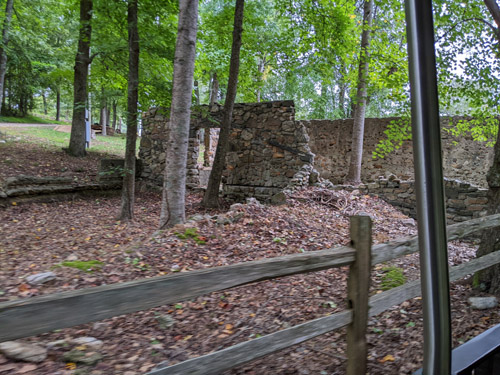
Train ride around the park!
Gold Museum Tour
Photo by Lori Carter

Juniors learned about the history of gold mining in Georgia
Photos by Lori Carter


The museum has many artifacts found on the property
Photo by Lori Carter

Remains of an ore cart found at the bottom of a mine shaft on the property.
The cart was a gondola that transported ore via a thick, overhead cable.
Photos by Lori Carter
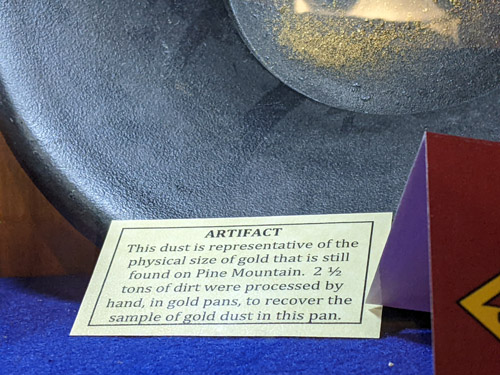

The placard on this item says:
"This dust is representative of the physical size of gold that is still found on Pine Mountain.
2 1/2 tons of dirt were processed by hand, in gold pans, to recover the sample of gold dust in this pan."
Photo by Lori Carter

Juniors enjoyed the mineral displays at the museum
Picnic!
Photo by Lori Carter

Picnic in the pavilion
Photo by Lori Carter

Cam grilled up a heap of hotdogs
Photo by Lori Carter

After lunch, Cam explained various tools used for gold panning...
Photo by Lori Carter

...a series of sieves to separate sediment by size...
Photo by Lori Carter

...various pans for panning for gold...
Photo by Lori Carter

...Wesley brought out a heavy metal pan for comparison to the modern plastic pans...
Photo by Lori Carter

...using a pipette to get the gold out of the pan.
Note the large magnet on the table for removing magnetite and iron sand.
A Hike Around the Mine
Photo by Lori Carter

Pit where ore was dug out
Photo by Lori Carter

Wesley showed us a place where a quartz outcropping is exposed
Photo by Lori Carter

We stopped to see remnants of some processing facilities
Photo by Lori Carter

Juniors were fascinated by the rocks in one of the mining areas
Associated Minerals in Gold Panning Sand
Photo by Lori Carter
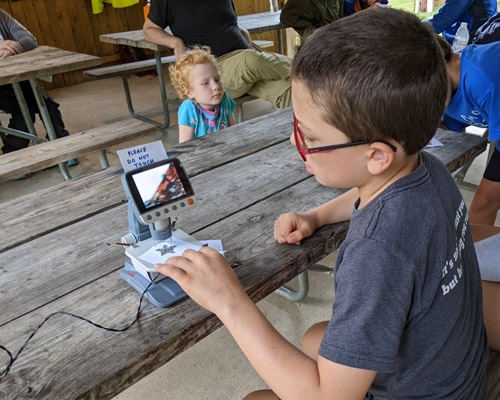
Juniors examined sand from gold panning to see other minerals associated with gold in Georgia
Photo by Lori Carter

One junior found a tiny piece of gold in his sand -- can you find it?
Photo by Lori Carter

There it is!
Gold Panning
Photo by Lori Carter

Cam tellin' panning tales
Photos by Lori Carter


Sand before panning and as it was being panned
Photos by Lori Carter


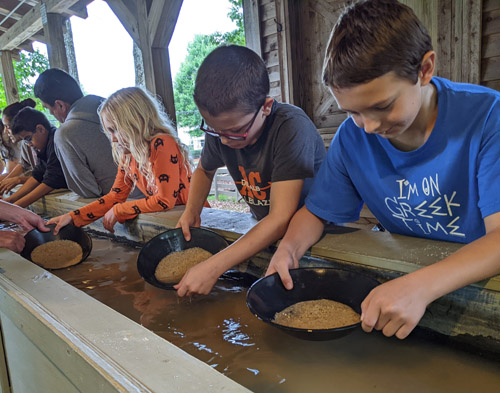

Juniors were so focused on panning!
Photo by Lori Carter

Their hard work paid off - gold on the left, tiny gemstones on the right!
Photo by Lori Carter
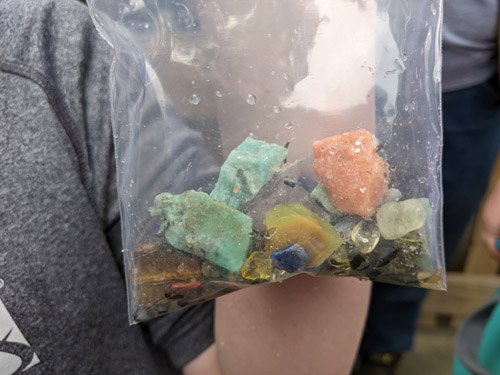
Some juniors did some optional gem grubbing, then spent time identifying what they grubbed
Flora and Fauna
Photo by Lori Carter

Stinkhorn mushroom with "horns" (easily identified by its smell - yes, that's how it got its name)
Photo by Lori Carter

Photogenic mushroom that juniors found inside one of the mining areas.
By the way, those "dots" on it are tiny bugs.
Photo by Lori Carter

Sweet little bumblebee on a beautiful bloom
No picture for this one, but a large spider startled a junior.
His blood-curdling scream startled the rest of us.
We all laughed about it later, and he offered to repeat the scream,
but we all agreed we had met our quota of blood-curdling screams for the day.
His blood-curdling scream startled the rest of us.
We all laughed about it later, and he offered to repeat the scream,
but we all agreed we had met our quota of blood-curdling screams for the day.
Click below for field trip policies

Copyright © Georgia Mineral Society, Inc.
